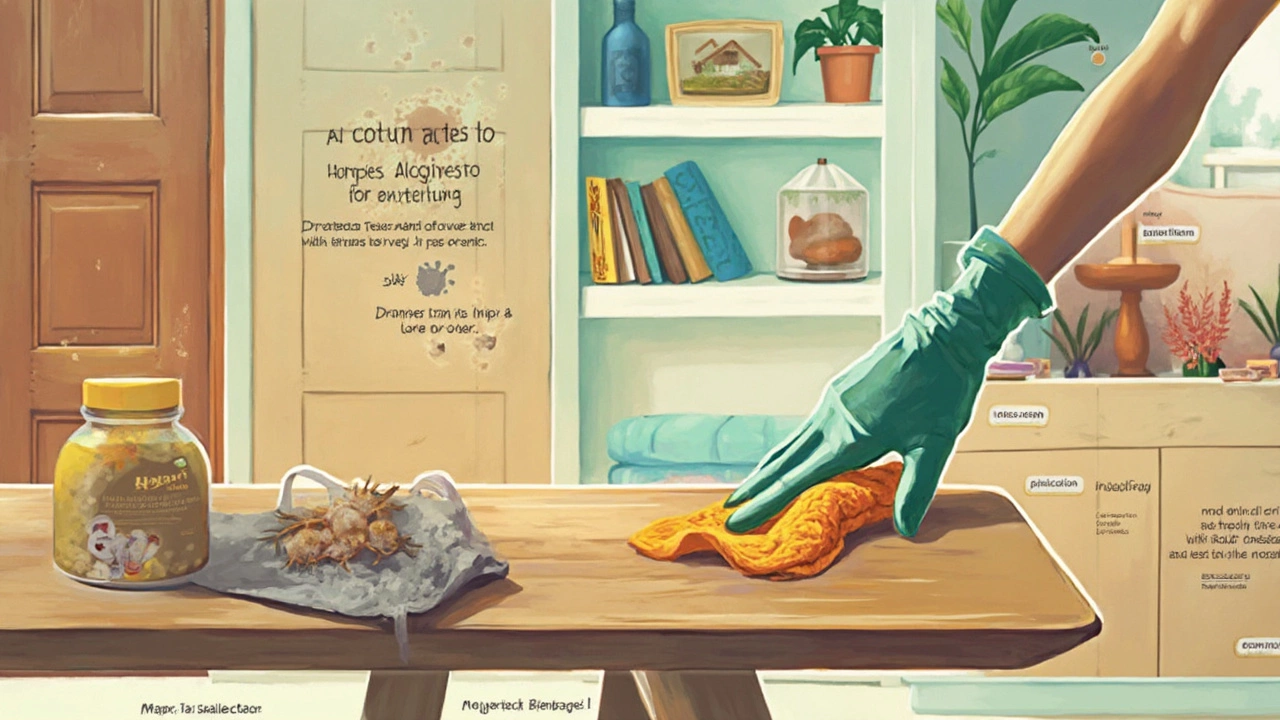Mold isn’t just a nuisance—it can turn your favorite couch into something you don’t even want to touch. If you plan to store furniture, knowing how to block mold right from the start is a real money-saver.
First, understand one thing: mold loves damp places. It doesn’t care how new or old your furniture is. Once it gets the right mix of humidity and darkness, it spreads fast. Storing furniture in basements or old garages? That’s like an open invitation for mold if you don’t take the right steps.
Here’s a quick trick most people miss: never shove your stuff directly against storage unit walls. Airflow matters. Even a few inches off the wall can make a difference, so let your furniture breathe a bit while it's packed away. Simple, right?
- Why Mold Loves Stored Furniture
- How to Prep Furniture for Storage
- Storage Choices: Tricks to Keep Mold Out
- Quick Tips for Checking and Maintaining Your Stuff
Why Mold Loves Stored Furniture
Here’s the deal: mold is just a kind of fungus, but it’s relentless when it comes to taking over your favorite chair or couch if the conditions are right. And storage spaces usually have the mix mold loves—low airflow, dust, darkness, and, especially, humidity. That’s the big one. If the air is sticky, something is going to start smelling funky sooner or later.
Let’s break it down:
- Humidity: Mold needs a humid environment, so if your storage space is above 60% humidity, it’s asking for trouble. Basements and non-climate-controlled units are the worst offenders.
- Organic materials: Wood, leather, and fabric are prime targets because mold eats anything from wood fibers to old skin cells trapped in upholstery. Plastic and metal? Less risk, but don’t bet on it—mold can use dirt on those surfaces too.
- Stale air: When there’s no circulation, moisture sticks around longer, making things worse. That’s why boxed-in furniture or piles pressed together boost your mold risk.
Ever seen numbers on how fast mold can show up? If there’s a water leak or soaking rain, mold spores can start growing in 24 to 48 hours. It’s that quick—so if your furniture went into storage even slightly damp, you’re pretty much handing mold the keys.
| Material | Mold Risk Level |
|---|---|
| Wood | High |
| Upholstered Fabric | High |
| Leather | Moderate |
| Plastic/Metal | Low/Medium (if dirty or damp) |
And get this: studies show that roughly 70% of mold growth in stored furniture comes from too much humidity, not just accidental spills. So, if you want to prevent mold on your furniture in storage, controlling moisture is half the battle.
How to Prep Furniture for Storage
If you want to prevent mold and keep your furniture fresh, you’ve got to do more than just haul it into a storage unit. Mold finds its way into every crack, especially if you skip the prep. A few careful steps before storage can make all the difference.
- Clean everything first. Dust, dirt, and old food crumbs on furniture invite mold by holding moisture. Use mild soap and water for wood, vacuum fabric couches and chairs, and wipe metal surfaces with a dry cloth. Remember, even new-looking pieces need cleaning.
- Dry it out—completely. Water is mold’s best friend. Let all items air-dry fully before wrapping or boxing them. If you’ve washed something, put it under a fan overnight. Rushing this part often leads to regrets.
- Use the right covers. Plastic wrap traps humidity—bad idea! Go for breathable furniture covers or old cotton sheets. Covers keep dust off and let air move, letting you dodge both mold and mildew.
- Furniture polish and sprays help. A light layer of wax on wood or a commercial conditioner on leather adds a bit of defense against the sneaky spores. Just check the label so you don’t damage surfaces.
- Disassemble big stuff. Take apart beds, tables, or shelving. It’s easier to store and helps air flow to all surfaces. Keep the hardware in a bag taped to the furniture so nothing gets lost.
- Check for hidden trouble spots. Don’t forget drawer bottoms, seat cushions, or under armrests. Mold likes hidden, soft areas—stick your nose in and sniff for that musty smell before you store.
Here’s a quick cheat sheet on which materials are riskier and how to deal with them:
| Material | Mold Risk | Best Prep Tip |
|---|---|---|
| Wood | High | Clean, dry, use wax polish |
| Fabric | Very High | Vacuum, check for moisture, use fabric spray |
| Leather | High | Wipe and treat with conditioner |
| Metal | Low | Dry, add silica gel packets nearby |
Getting your furniture ready the right way is the backbone of mold prevention. It beats trying to fix the damage later, trust me.

Storage Choices: Tricks to Keep Mold Out
Let’s be real—where you stash your furniture matters a lot if you want to prevent mold. Not all storage spots are equal. Some spaces pretty much guarantee you’ll be dealing with funky smells down the line.
- Climate-controlled units daily beat regular ones. Normal storage units can get super humid or cold, and that’s the perfect combo for mold. Climate control means they keep things between 55–80°F and watch the humidity, usually staying under 55%. That’s your mold kryptonite.
- Pick a spot above ground level. Basements and ground floors soak up moisture. Even a few extra feet up can mean drier air and less risk for your stuff.
- Use pallets or shelving, not just concrete slabs. Furniture sitting on bare concrete can wick up moisture from the floor, so go for wood pallets or metal racks.
- Strong airflow is your friend. Units with vent slots or fans built in keep the air moving. Still, stagnant air speeds up mold growth.
| Storage Type | Mold Risk Level | Average Humidity |
|---|---|---|
| Climate-Controlled | Low | ~50% |
| Outdoor Shed | High | Up to 80% |
| Garage (Unheated) | Medium–High | 60–75% |
If you can’t get climate control, there’s another trick: add a few canisters of moisture absorbers like silica gel or DampRid. Swap them every couple months. It’s a cheap move that can make a big difference for mold prevention.
Finally, don’t cram your space to the ceiling. Furniture jammed in tight holds onto moisture. Leave at least a hand’s width between pieces and the walls. Air needs to be able to drift through, not get locked in.
Quick Tips for Checking and Maintaining Your Stuff
If you want to keep mold from sneaking up on your stored furniture, you can’t just set it and forget it. You’ve got to check up on your stuff—and a little effort goes a long way.
- Pop into your storage spot every few weeks, especially during humid months. Bring a flashlight and peek under cushions, inside drawers, and behind pieces. Mold usually starts where you can’t see it right away.
- Feel for dampness or a musty smell—these are classic mold red flags. Your nose actually knows, so don’t ignore it if the space suddenly has that basement odor.
- Keep a small digital humidity gauge (hygrometer) in your storage unit. Experts agree: keeping humidity below 60% is key for mold prevention. If you spot readings over that, think about adding more moisture control—like extra desiccant packs or another dehumidifier.
- Rotate or move the furniture around a bit when you visit. This keeps air moving and stops any one area from getting too stagnant.
- If you find any mold, deal with it fast. Take the piece outside, clean it with a solution of water and a little white vinegar, then dry it completely before putting it back in storage.
Here’s a quick look at how storage habits impact mold prevention and storage tips:
| Storage Habit | Effect on Mold Risk |
|---|---|
| Regular checks (every 3-4 weeks) | Lowers mold risk by catching issues early |
| Ignoring stored items for 2+ months | Drastically increases mold and odor risk |
| Using a dehumidifier | Reduces moisture, keeps air dry |
| Keeping furniture directly on the floor | Much higher risk, especially after storms or leaks |
Even quick monitoring helps keep your furniture storage safe and extends the life of your stuff. A little attention now saves you a headache later.

